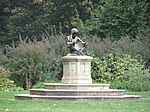Virginia B. Fairbanks Art & Nature Park: 100 Acres

The Virginia B. Fairbanks Art & Nature Park: 100 Acres, also referred to as the 100 Acres or Fairbanks Park, is a public interactive art park located on the Newfields (Indianapolis Museum of Art) campus in Indianapolis, Indiana, United States. Opened in 2010, the 100-acre (40 ha) park is among the largest of its kind in the U.S., including an inaugural collection of eight site-specific art installations by national and international artists. Other features include walking paths, natural landscaping, and the Ruth Lilly Visitors Pavilion. Admission to the park is free and open from dusk to dawn. The park is situated within a floodplain west of the Indianapolis Museum of Art and Oldfields, bordered on the east by the Indiana Central Canal and on the north and west by a meander in the White River. The park was intentionally developed to emphasize surrounding natural features, including woods, meadows, wetlands, and a 30-to-40-acre (12 to 16 ha) quarry lake. Virginia B. Fairbanks, the wife of benefactor Richard M. Fairbanks, is the park's namesake.
Excerpt from the Wikipedia article Virginia B. Fairbanks Art & Nature Park: 100 Acres (License: CC BY-SA 3.0, Authors, Images).Virginia B. Fairbanks Art & Nature Park: 100 Acres
North White River Parkway East Drive, Indianapolis
Geographical coordinates (GPS) Address Nearby Places Show on map
Geographical coordinates (GPS)
| Latitude | Longitude |
|---|---|
| N 39.827305555556 ° | E -86.190305555556 ° |
Address
Funky Bones
North White River Parkway East Drive
46208 Indianapolis
Indiana, United States
Open on Google Maps







